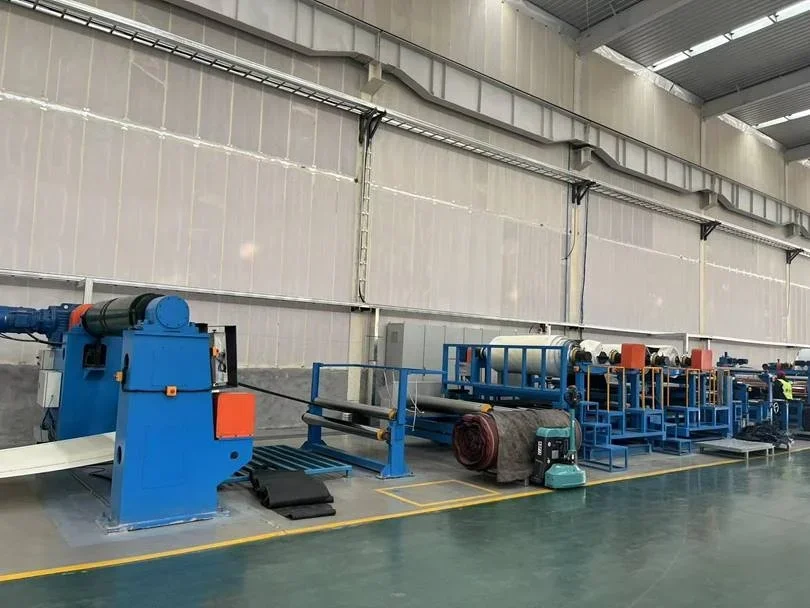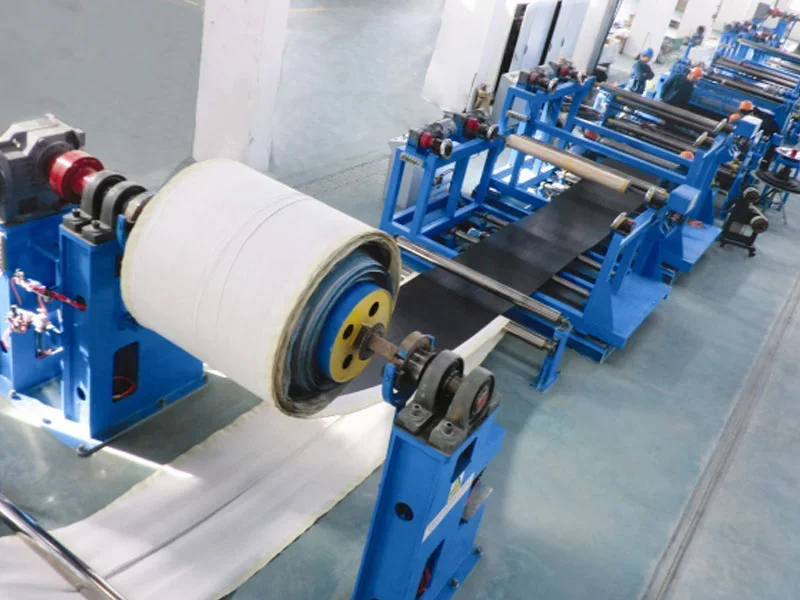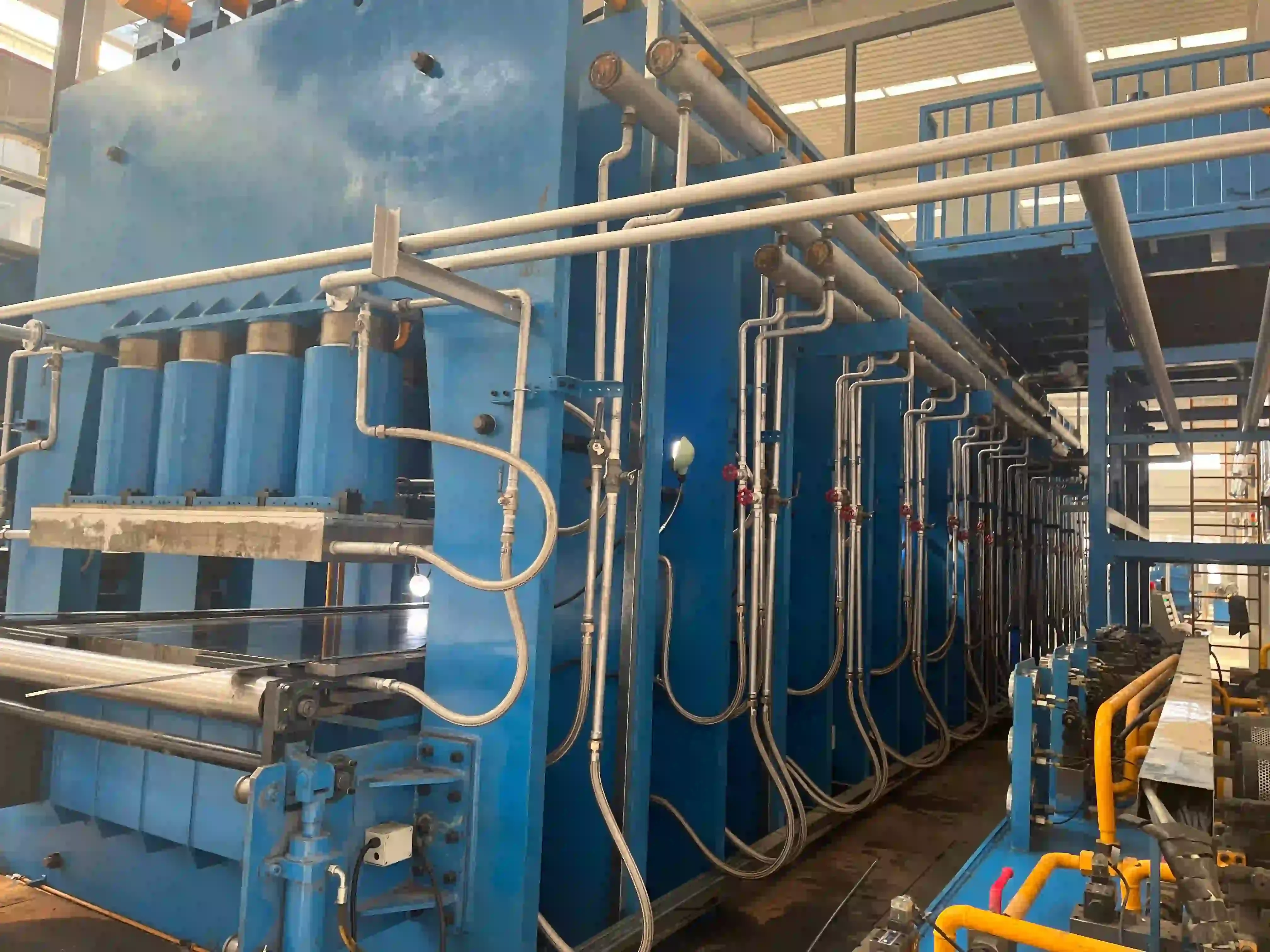In the realm of manufacturing, the constant tension forming production line is a crucial component. One pivotal element within this setup is the conveyor belt. This essential part ensures the seamless flow of materials throughout the production process, maintaining efficiency and precision. Understanding the significance of a well-functioning conveyor belt in this context is paramount for optimizing productivity and quality output.
The interplay between the conveyor belt and constant tension forming production line showcases a harmonious synergy that drives operational success.
Understanding Conveyor Belt Forming
Production Line Efficiency
Conveyor belt constant tension forming in production lines ensures a seamless flow of materials. Conveyor belts facilitate the movement of items along the production process, optimizing efficiency.
All Operations on Same Level
Having all forming operations on the same level streamlines the production process. This setup minimizes disruptions and enhances the overall workflow.
Reduced Operating Strength
Importance of Constant Tension Technology
Adjustable Speed
Conveyor belt constant tension forming production lines rely on constant tension technology to ensure smooth operations. By incorporating adjustable forming speed, manufacturers can optimize production efficiency. This feature allows for flexible control over the speed of the conveyor belt, accommodating various production requirements.
Maintaining a consistent belt tension is crucial in conveyor belt production to prevent slippage and ensure product quality. The implementation of constant tension technology enables manufacturers to achieve precise tension levels throughout the production process. This results in improved product consistency and reduced downtime due to belt misalignment or slipping issues.
PLC Control Systems
One of the key components that contribute to maintaining constant tension in conveyor belt production lines is the integration of PLC (Programmable Logic Controller) control systems. These systems play a vital role in regulating the tension of the conveyor belt by continuously monitoring and adjusting the motor speed based on preset parameters.
-
Ensures real-time adjustments
-
Enhances operational stability
-
Minimizes manual intervention

Benefits of Tension Forming in Production
Improved Product Quality
Tension forming in production significantly enhances product quality by ensuring uniformity and consistency throughout the manufacturing process. This method reduces the risk of defects such as wrinkles, uneven stretching, or misalignment, resulting in higher-quality products.
The use of tension during forming helps to eliminate variations in material thickness and shape irregularities that can occur during production. By maintaining a constant tension level, manufacturers can achieve precise control over the shaping process, leading to products with superior finish and accuracy.
Consistent Product Output
A key benefit of tension forming is its ability to deliver consistent product output. By applying a constant level of tension to the material being processed, manufacturers can ensure that each item produced adheres to the desired specifications without deviations.
-
Ensures uniformity
-
Reduces rejects
Consistency in product output is crucial for meeting customer expectations and maintaining high standards of quality across all batches. The use of tension forming technology helps manufacturers achieve this level of consistency efficiently and effectively.
Enhanced Production Process
The integration of tension forming into the production line brings about several enhancements to the overall manufacturing process. By incorporating constant tension technology, manufacturers can streamline operations, increase productivity, and optimize resource utilization.
-
Streamlines operations
-
Increases productivity
-
Optimizes resource utilization
Constant tension forming allows for smoother material flow along the conveyor belt, reducing bottlenecks and minimizing downtime. This results in improved efficiency and throughput rates within the production line, ultimately leading to cost savings and enhanced profitability.
Key Components of Production Lines
Automation Systems
Automation systems play a crucial role in conveyor belt constant tension forming production lines. These systems ensure efficient and precise movement of materials along the line, reducing manual labor and increasing productivity. By automating tasks such as material handling and quality control, companies can achieve higher accuracy and consistency in their production processes.
Tension Control Units
Tension control units are essential components in conveyor belt forming production lines. They help maintain consistent tension levels throughout the manufacturing process, ensuring uniformity in product quality. By regulating the tension applied to the conveyor belt, these units prevent issues such as wrinkles or misalignment, leading to smoother operations and improved final product outcomes.
Monitoring Sensors
Monitoring sensors are critical for detecting any deviations or abnormalities in the production line. These sensors provide real-time data on factors like speed, temperature, and alignment, allowing operators to identify and address issues promptly. By integrating monitoring sensors into the system, companies can minimize downtime, reduce waste, and enhance overall operational efficiency.
Quality Inspection Systems
Quality inspection systems are indispensable for ensuring that products meet specified standards during the manufacturing process. These systems utilize advanced technologies such as cameras and software algorithms to inspect products for defects or inconsistencies. By conducting thorough quality checks at various stages of production, companies can uphold high-quality standards and prevent defective products from reaching customers.
Data Analytics Software
Incorporating data analytics software into production lines enables companies to gather valuable insights into their operations. This software analyzes data collected from various components of the production line, identifying patterns, trends, and potential areas for improvement. By leveraging data analytics tools, organizations can make informed decisions to optimize processes, enhance productivity, and drive continuous innovation.
Machinery Essentials for Belt Production
Equipment List
-
Belt Feeder
-
Pulleys
-
Sidewall Belting
-
Composite Idlers
-
Belt Cleaner
Conveyor belt constant tension forming production lines rely on several essential pieces of machinery to ensure efficient and quality belt production. The belt feeder is crucial for maintaining a steady flow of materials onto the conveyor belt.
Functions of Essential Machinery
The pulleys play a vital role in guiding the belt along the production line, ensuring smooth movement and proper belt alignment. Sidewall belting helps contain bulk materials within the belt, preventing spillage and maintaining operational efficiency.
Composite idlers are designed to reduce friction and wear on the belt, extending its lifespan and minimizing maintenance costs. The belt cleaner is responsible for removing debris and buildup from the belt's surface, preventing damage and enhancing overall performance.
Impact on Product Quality
The integration of advanced machinery such as composite idlers and specialized belt cleaners significantly improves the final product quality. By reducing belt wear and ensuring proper cleaning, these technologies enhance the durability and longevity of the belts produced.
Innovative equipment like sidewall belting enhances the containment of bulk materials, reducing spillage and improving overall operational efficiency. The precise functions of each machinery contribute to a seamless production process, resulting in high-quality, durable belts that meet industry standards.

Advanced Control Systems in Manufacturing
Vector Variable Frequency Motors
Conveyor belt constant tension forming production lines benefit from vector variable frequency motors. These motors offer precise speed control, reducing wear and tear on the system. By adjusting the frequency and voltage, they optimize energy consumption efficiently.
Vector variable frequency motors ensure smooth acceleration and deceleration of the conveyor belt, enhancing handling systems' overall performance. This feature prevents sudden stops or jerky movements, promoting a consistent material flow throughout the operation.
Intelligent Tension Let Off Systems
Intelligent tension let off systems play a crucial role in maintaining optimal tension levels during production. By automatically adjusting tension based on real-time feedback, these systems prevent issues like material buildup and cupping. This results in a more uniform product output.
These systems enhance the bulk material handling systems, ensuring that the conveyor belt operates at an ideal tension level at all times. With intelligent tension control, manufacturers can minimize downtime caused by manual adjustments and reduce the risk of product defects.
Safety and Quality Assurance Measures
Necessary Safety Precautions
Conveyor belt constant tension forming production lines require necessary safety precautions to protect workers and maintain operational efficiency. Safety measures such as proper guarding of moving parts, regular maintenance checks by trained personnel, and secure covers on all access points are essential.
Reliability Procedures
To ensure the reliability of the conveyor belt system, strict procedures must be followed. Regular inspections by qualified maintenance personnel help identify any issues promptly. Addressing concerns in the loading area and potential causes of malfunctions like carryback is crucial for uninterrupted production.
Quality Assurance for Consistency
Quality assurance plays a vital role in maintaining product consistency along the conveyor belt line. Implementing rigorous quality checks at various stages helps in identifying defects early on, reducing waste and ensuring that only high-quality products reach the end of the line.
Importance of Safety in Productivity
Maintaining a safe working environment not only protects employees but also contributes to a more productive manufacturing process. When safety protocols are strictly followed, the risk of accidents decreases, leading to fewer disruptions in production schedules and improved overall efficiency.
Innovative Tools for Efficiency and Quality
Technology Advancements
Technology advancements play a crucial role in enhancing productivity and efficiency in manufacturing processes. These advancements include design improvements in conveyor belt constant tension forming production lines, enabling smoother operations and reduced downtime.
Incorporating advanced tracking systems ensures precise monitoring of materials throughout the production process. This technology optimizes vertical handling and minimizes errors, leading to higher profit margins for companies utilizing these innovative tools.
Impact on Production Line Performance
The implementation of cutting-edge cleaning mechanisms enhances the overall cleanliness of the production line, ensuring optimal operation. These cleaners are designed to efficiently remove debris and contaminants, maintaining a high level of hygiene essential for quality assurance measures.
By integrating state-of-the-art heat-resistant materials in the conveyor belt system, companies can reduce maintenance costs and enhance durability. This improvement directly impacts the production line's capacity, allowing for increased output without compromising on quality.
Efficiency Enhancement
The utilization of expert-designed conveyor belt systems significantly improves operational efficiency by streamlining material flow and reducing manual handling. The incorporation of specialized support structures further enhances the system's stability, contributing to a seamless production process.
Implementing innovative tools such as automated cleaning systems and precision tracking mechanisms results in a more streamlined operation with minimal disruptions. Companies benefit from reduced maintenance costs and improved overall performance, ultimately maximizing their profits.

Closing Thoughts
In grasping the intricacies of conveyor belt constant tension forming production lines, one understands the critical role of technology in enhancing efficiency and quality. The fusion of constant tension mechanisms with advanced control systems not only ensures precision but also elevates safety standards. Embracing these innovations is paramount for streamlining production processes and achieving optimal outcomes.
For those invested in the realm of manufacturing, delving into the realm of constant tension forming holds promise for heightened productivity and output excellence. By integrating cutting-edge technologies and stringent quality assurance measures, manufacturers can pave the way for sustainable growth and operational excellence in the ever-evolving landscape of production. Explore further to unlock the full potential of conveyor belt constant tension forming production lines.
Frequently Asked Questions
What is the significance of constant tension technology in conveyor belt forming?
Constant tension technology ensures uniformity in product quality by maintaining consistent pressure on the conveyor belt throughout the production process. This results in improved efficiency and reduces the likelihood of defects or inconsistencies in the final products.
What are the key components required for a production line utilizing conveyor belt forming?
Essential components include conveyor belts, rollers, motors, sensors, control systems, and safety devices. These elements work together to ensure smooth operation, precise control over the manufacturing process, and adherence to safety standards.
How do advanced control systems contribute to enhancing manufacturing processes in belt production lines?
Advanced control systems optimize operations by enabling real-time monitoring, adjustments based on data insights, and automation of tasks. This leads to increased productivity, accuracy in product specifications, and quicker response to changing production requirements.
Why are safety and quality assurance measures crucial in conveyor belt forming production lines?
Safety measures protect workers from accidents while quality assurance practices ensure that products meet specified standards. By prioritizing safety and quality, companies can uphold their reputation, prevent costly errors, and maintain a safe working environment for employees.
Which innovative tools can be employed to enhance efficiency and quality in conveyor belt forming production lines?
Tools such as automated inspection systems, predictive maintenance software, robotics for handling tasks, and IoT devices for data collection play a vital role in improving efficiency and maintaining high-quality standards in conveyor belt forming production lines.

